Quick Summary:
- Define your profitable niche and choose the right e-commerce platform.
- Design a user-friendly website with captivating product displays.
- Find and vet reliable dropshipping suppliers for quality service.
- Drive sales through marketing and provide excellent customer service.
Table of Contents
- Introduction: Your Gateway to E-Commerce Freedom
- 1. Understanding the Dropshipping Model: A Quick Recap
- 2. Defining Your Niche: Finding Your Winning Product
- 3. Choosing the Right E-Commerce Platform: Your Foundation for Success
- 4. Designing Your Website: Creating a Captivating Online Storefront
- 5. Finding and Vetting Dropshipping Suppliers: Your Partners in Success
- 6. Setting Up Payment Gateways and Shipping Options: Streamlining the Customer Experience
- 7. Marketing Your Dropshipping Website: Driving Traffic and Generating Sales
- 8. Customer Service: Building Loyalty and Trust
- 9. Legal Considerations: Protecting Your Business
- 10. Scaling Your Dropshipping Business: Growth Strategies
- 11. Qrolic Technologies: Your Partner in E-Commerce Design and Development
- Conclusion: Your Journey to E-Commerce Success Starts Now
Introduction: Your Gateway to E-Commerce Freedom
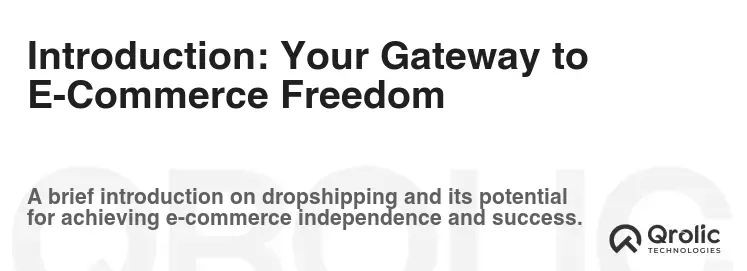
Ready to ditch the 9-to-5 and become your own boss? Dropshipping offers a fantastic path to entrepreneurial freedom, and at the heart of your journey lies your dropshipping website. Think of it as your virtual storefront, open 24/7, ready to serve customers worldwide. This isn’t just about slapping up a few products; it’s about crafting an engaging, user-friendly, and conversion-optimized experience that turns visitors into loyal customers. This guide dives deep into every facet of dropshipping website creation, from initial planning to advanced optimization, ensuring you’re equipped to build a thriving online business.
1. Understanding the Dropshipping Model: A Quick Recap
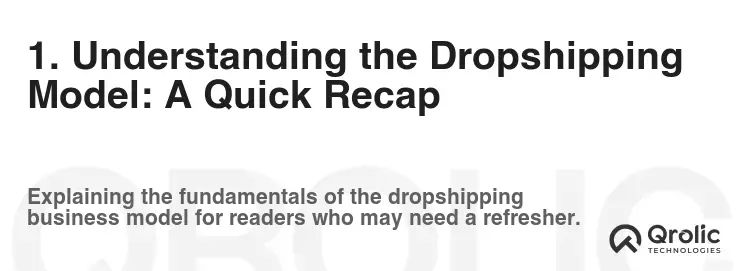
Before diving into website specifics, let’s solidify our understanding of dropshipping. In essence, you sell products without holding any inventory yourself. When a customer places an order on your website, you forward that order to a third-party supplier (the dropshipper), who then ships the product directly to the customer. Your profit is the difference between the price you charge the customer and the price you pay the supplier.
Why is this model so appealing?
- Low Startup Costs: No need to invest heavily in inventory upfront.
- Reduced Risk: You only pay for products when a customer buys them.
- Flexibility: Run your business from anywhere with an internet connection.
- Scalability: Easily expand your product offerings without inventory concerns.
- Wide Product Selection: Offer a diverse range of products without physical limitations.
The Downsides (and how to mitigate them):
- Lower Profit Margins: Competition can drive down prices, impacting profitability.
- Inventory Management Challenges: You rely on your supplier for accurate stock information.
- Shipping Complications: Coordinating shipping with multiple suppliers can be complex.
- Supplier Reliability: Choosing reliable suppliers is crucial for product quality and timely delivery.
- Customer Service Responsibility: You’re responsible for handling customer inquiries and complaints, even though you don’t handle the products directly.
Mitigation Strategies: Focus on niche products, build strong supplier relationships, implement robust inventory tracking systems, and prioritize exceptional customer service.
2. Defining Your Niche: Finding Your Winning Product

Choosing the right niche is paramount to your success. Don’t just sell “stuff”; sell solutions, passions, and curated experiences. A well-defined niche makes marketing easier, attracts a targeted audience, and allows you to become an authority in your field.
How to identify a profitable niche:
- Follow Your Passion: What are you genuinely interested in? Selling products you’re passionate about makes the process more enjoyable and authentic.
- Identify Problems to Solve: What needs are unmet? What pain points can you address with specific products?
- Research Trending Products: Use tools like Google Trends, social media, and e-commerce marketplaces (Amazon, eBay, Etsy) to identify rising product categories.
- Analyze the Competition: Are there existing players in the niche? If so, how can you differentiate yourself? Can you target a sub-niche?
- Consider Profit Margins: Ensure that the products you choose offer sufficient profit potential after factoring in supplier costs and marketing expenses.
- Look for Evergreen Products: Focus on products that have consistent demand rather than fleeting trends.
Niche Examples:
- Sustainable Baby Products: Organic clothing, reusable diapers, eco-friendly toys.
- Home Coffee Brewing: Specialty coffee beans, brewing equipment, accessories.
- Pet Tech Gadgets: Smart feeders, GPS trackers, interactive toys.
- Minimalist Travel Gear: Lightweight backpacks, travel organizers, portable electronics.
- Home Fitness Equipment: Resistance bands, yoga mats, dumbbells
Validating Your Niche:
Before committing fully, test the waters with market research.
- Keyword Research: Use tools like Google Keyword Planner, Ahrefs, or Semrush to assess search volume and competition for relevant keywords.
- Social Media Engagement: Gauge interest by creating social media accounts and posting relevant content.
- Competitor Analysis: Study your competitors’ websites, social media, and marketing strategies.
- Miniature Test: Consider running a small ad campaign using Google or Social media and see if you get any traffic and sales for your product and if yes what is the conversion rate?
3. Choosing the Right E-Commerce Platform: Your Foundation for Success
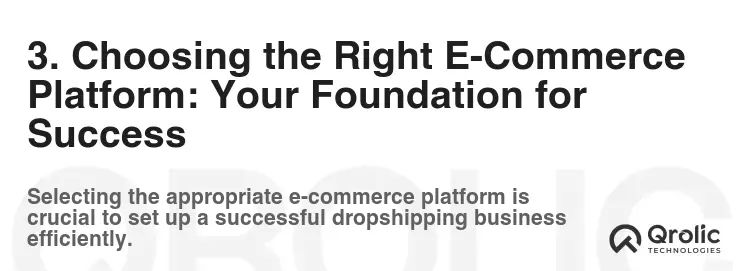
Selecting the right e-commerce platform is a critical decision. It will dictate your website’s functionality, scalability, and overall user experience. Here are some popular options:
- Shopify: A comprehensive, user-friendly platform specifically designed for e-commerce. Offers a wide range of apps and integrations for dropshipping.
- Pros: Easy to use, strong app ecosystem, excellent customer support, scalable.
- Cons: Transaction fees (unless using Shopify Payments), can be expensive for advanced features.
- WooCommerce (wordpress): A flexible, open-source plugin that transforms your WordPress website into an e-commerce store.
- Pros: Highly customizable, large community support, cost-effective (if you already have a WordPress site), full control over your data.
- Cons: Requires more technical knowledge, security vulnerabilities if not properly maintained.
- BigCommerce: A robust platform with advanced features and scalability for larger businesses.
- Pros: Powerful features, built-in SEO tools, no transaction fees, excellent support.
- Cons: More complex to set up, more expensive than Shopify or WooCommerce.
- Squarespace: A simple, aesthetically pleasing platform suitable for small businesses and individuals.
- Pros: Easy to use, visually appealing templates, all-in-one platform (hosting included).
- Cons: Limited customization options, fewer integrations than Shopify or WooCommerce.
Key Considerations When Choosing a Platform:
- Ease of Use: How comfortable are you with the platform’s interface and functionality?
- Scalability: Can the platform handle your growing business needs?
- Dropshipping Integrations: Does the platform offer integrations with popular dropshipping apps and suppliers?
- SEO Capabilities: Does the platform provide SEO-friendly features and tools?
- Payment Gateways: Does the platform integrate with your preferred payment gateways (e.g., PayPal, Stripe)?
- Customer Support: What level of customer support is offered?
- Pricing: What are the platform’s monthly fees, transaction fees, and other costs?
Recommendation: For beginners, Shopify is generally the most user-friendly and well-supported option. For those with technical skills and a WordPress website, WooCommerce can be a cost-effective choice.
4. Designing Your Website: Creating a Captivating Online Storefront
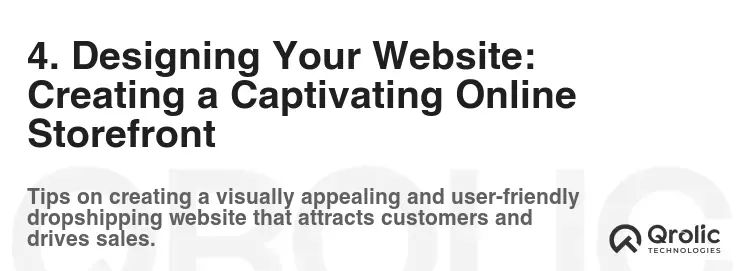
Your website’s design is your first impression. It needs to be visually appealing, easy to navigate, and optimized for conversions.
Essential Design Elements:
- Clean and Professional Layout: Avoid clutter and use a consistent design scheme.
- High-Quality Product Images: Showcase your products with clear, attractive images and videos.
- Mobile-Responsive Design: Ensure your website looks and functions flawlessly on all devices (desktops, tablets, smartphones).
- Easy Navigation: Make it easy for customers to find what they’re looking for. Use clear menus, search functionality, and product categories.
- Compelling Product Descriptions: Write informative and persuasive descriptions that highlight the benefits of your products.
- Clear Call-to-Actions (CTAs): Guide customers to take the desired action (e.g., “Add to Cart,” “Buy Now,” “Learn More”).
- Trust Signals: Build trust by displaying customer reviews, testimonials, security badges, and guarantees.
- Fast Loading Speed: Optimize your website for speed. slow loading times can lead to high bounce rates.
Homepage Best Practices:
- Hero Image/Video: Capture attention with a visually stunning hero image or video that showcases your brand and products.
- Clear Value Proposition: Communicate what makes your business unique and why customers should buy from you.
- Featured Products: Highlight your best-selling or most popular products.
- Customer Testimonials: Display positive reviews and testimonials to build credibility.
- Email Signup Form: Encourage visitors to subscribe to your email list.
- Easy Navigation: Make sure visitor can find the desired product easily.
Product Page Optimization:
- High-Resolution Images: Showcase your products from multiple angles.
- Detailed Product Descriptions: Provide comprehensive information about the product’s features, benefits, and specifications.
- Customer Reviews: Encourage customers to leave reviews and ratings.
- Related Products: Suggest complementary products to increase sales.
- Clear Pricing and Shipping Information: Be transparent about pricing and shipping costs.
- Add to Cart Button: Make it easy for customers to add the product to their cart.
- Trust Badges: Display trust badges to build confidence and ensure visitor your website is authentic and secure.
Choosing a Theme/Template:
- Paid vs. Free: Paid themes generally offer more features, customization options, and support.
- Industry-Specific Themes: Consider themes designed specifically for your niche.
- Mobile Responsiveness: Ensure the theme is fully mobile-responsive.
- Customization Options: How easily can you customize the theme to match your brand?
- Reviews and Ratings: Check the theme’s reviews and ratings before purchasing.
- Test the Theme: Try the theme’s demo to determine whether it fits your requirements
5. Finding and Vetting Dropshipping Suppliers: Your Partners in Success
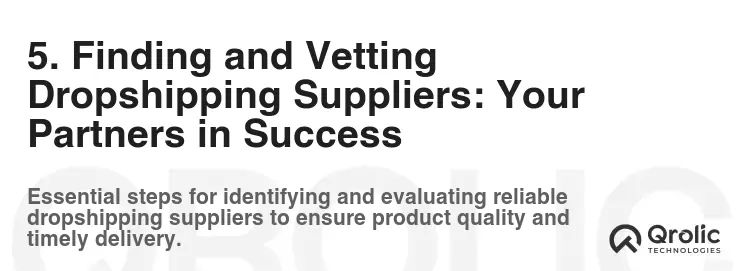
Your suppliers are the backbone of your dropshipping business. Choosing reliable and trustworthy suppliers is crucial for product quality, timely delivery, and customer satisfaction.
Where to Find Suppliers:
- Oberlo (Shopify App): A popular app that connects you with suppliers offering a wide range of products.
- AliExpress: A massive online marketplace with millions of products from Chinese suppliers.
- SaleHoo: A directory of vetted dropshipping suppliers.
- Worldwide Brands: Another directory of certified dropshippers.
- Spocket: A dropshipping platform focused on suppliers in the US and Europe.
- Doba: A dropshipping platform that connects you with dropshipping suppliers and products.
Key Factors to Consider When Vetting Suppliers:
- Product Quality: Order samples to assess the quality of their products.
- Shipping Times: Ensure they offer reasonable shipping times.
- Communication: Evaluate their responsiveness and communication skills.
- Customer Service: Assess their ability to handle customer inquiries and complaints.
- Pricing: Compare their prices with other suppliers.
- Return Policies: Understand their return policies and procedures.
- Inventory Management: How accurately do they track inventory levels?
- Minimum Order Quantities: Do they have minimum order requirements?
- Dropshipping Expertise: Do they have experience with dropshipping?
- Reliability and Reputation: Research their reputation online and check for reviews.
Building Strong Supplier Relationships:
- Clear Communication: Communicate your expectations clearly and maintain open communication.
- Timely Payments: Pay your suppliers on time.
- Treat Them with Respect: Build a positive and professional relationship.
- Address Issues Promptly: Address any issues or concerns promptly and professionally.
- Negotiate Better Pricing: As your sales volume increases, negotiate better pricing with your suppliers.
6. Setting Up Payment Gateways and Shipping Options: Streamlining the Customer Experience
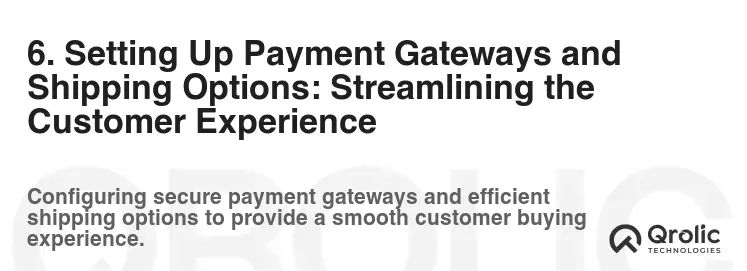
Providing seamless payment and shipping options is crucial for a positive customer experience.
Payment Gateways:
- PayPal: A widely used and trusted payment gateway.
- Stripe: A popular payment gateway for businesses.
- Shopify Payments: Shopify’s built-in payment gateway.
- Authorize.net: A secure and reliable payment gateway.
Factors to Consider When Choosing a Payment Gateway:
- Transaction Fees: Compare the transaction fees charged by different gateways.
- Security: Ensure the gateway provides secure payment processing.
- Integration: Does the gateway integrate with your e-commerce platform?
- Customer Support: What level of customer support is offered?
- Accepted Payment Methods: Does the gateway accept your customers’ preferred payment methods?
- Payout Schedule: When the payout will happen and what are the conditions.
Shipping Options:
- Flat Rate Shipping: Charge a fixed shipping fee for all orders.
- Free Shipping: Offer free shipping on orders over a certain amount.
- Calculated Shipping: Calculate shipping costs based on weight, dimensions, and destination.
- Expedited Shipping: Offer faster shipping options for an additional fee.
- Dropshipping Supplier Shipping: Typically you have to follow suppliers shipping guideline but make sure it is adequate for your customer.
Shipping Best Practices:
- Transparency: Be transparent about shipping costs and delivery times.
- Accurate Tracking: Provide customers with tracking information.
- Fast Shipping: Aim for fast and reliable shipping.
- Packaging: Make sure supplier provide good quality packaging that protects the product and gives professional look.
- International Shipping: If you offer international shipping, clearly outline the costs, duties, and taxes.
7. Marketing Your Dropshipping Website: Driving Traffic and Generating Sales
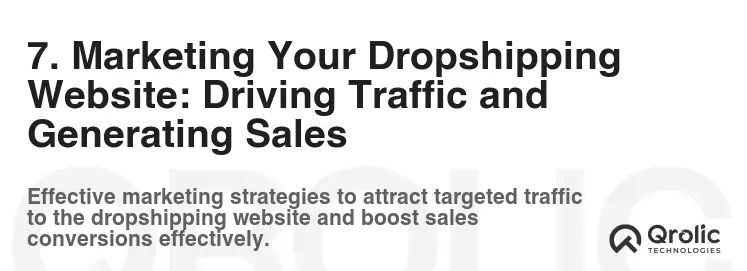
Building a great website is only half the battle. You need to actively market your website to attract traffic and generate sales.
Effective Marketing Strategies:
- Search Engine Optimization (SEO): Optimize your website and content for relevant keywords to rank higher in search engine results.
- Keyword Research: Identify the keywords your target audience is searching for.
- On-Page Optimization: Optimize your website’s title tags, meta descriptions, and content for relevant keywords.
- Off-Page Optimization: Build backlinks from other websites to improve your website’s authority.
- Content Marketing: Create valuable and engaging content (blog posts, articles, videos) that attracts and educates your target audience.
- Social Media Marketing: Engage with your target audience on social media platforms.
- Choose the Right Platforms: Focus on the platforms where your target audience is most active.
- Create Engaging Content: Share compelling content that resonates with your audience.
- Run Contests and Giveaways: Generate excitement and increase brand awareness.
- Social Media Advertising: Use targeted advertising to reach a wider audience.
- Paid Advertising (PPC): Run paid advertising campaigns on search engines and social media.
- Google Ads: Advertise your products on Google search results.
- Facebook Ads: Target specific demographics and interests on Facebook.
- Email Marketing: Build an email list and send targeted email campaigns.
- Offer a Lead Magnet: Provide a valuable incentive (e.g., a discount code, a free e-book) in exchange for email signups.
- Segment Your List: Segment your email list based on customer behavior and preferences.
- Send Personalized Emails: Personalize your emails to increase engagement.
- Influencer Marketing: Partner with influencers to promote your products to their followers.
- Identify Relevant Influencers: Find influencers whose audience aligns with your target market.
- Reach Out to Influencers: Contact influencers and propose a collaboration.
- Track Your Results: Monitor the performance of your influencer marketing campaigns.
- Content Marketing:
- Blog posts
- Infographics
- Guides
- Case studies
- Affiliate Marketing: Partner with affiliates to promote your products and earn a commission on sales.
Marketing Best Practices:
- Set Clear Goals: Define your marketing goals (e.g., increase website traffic, generate leads, drive sales).
- Track Your Results: Monitor the performance of your marketing campaigns and make adjustments as needed.
- Experiment and Iterate: Try different marketing strategies and tactics and iterate based on your results.
- Be Patient: Building a successful dropshipping business takes time and effort.
8. Customer Service: Building Loyalty and Trust
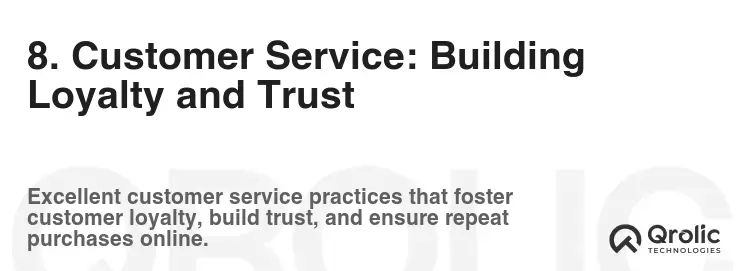
Exceptional customer service is paramount for building a loyal customer base and ensuring long-term success. Remember, even though you’re not directly handling the products, you are the face of the business for your customers.
Key Elements of Great Customer Service:
- Prompt and Helpful Responses: Respond to customer inquiries quickly and provide helpful information.
- Clear Communication: Communicate clearly and professionally.
- Empathy and Understanding: Show empathy for customer concerns and try to understand their perspective.
- Problem-Solving Skills: Be able to resolve customer issues effectively and efficiently.
- Proactive Communication: Keep customers informed about their order status and any potential delays.
- Easy Returns and Refunds: Offer a straightforward return and refund policy.
Tools and Strategies for Providing Excellent Customer Service:
- Live Chat: Provide real-time support through live chat on your website.
- Email Support: Respond to customer emails promptly and professionally.
- Help Desk Software: Use help desk software to manage customer inquiries and track support tickets.
- FAQ Page: Create a comprehensive FAQ page to answer common customer questions.
- Social Media Monitoring: Monitor social media for customer mentions and respond to inquiries and complaints.
Handling Difficult Customers:
- Stay Calm: Remain calm and professional, even when dealing with angry or frustrated customers.
- Listen Actively: Listen carefully to the customer’s concerns and try to understand their perspective.
- Acknowledge Their Feelings: Acknowledge the customer’s feelings and show empathy.
- Offer a Solution: Provide a solution that addresses the customer’s concerns.
- Follow Up: Follow up with the customer to ensure they are satisfied with the resolution.
9. Legal Considerations: Protecting Your Business
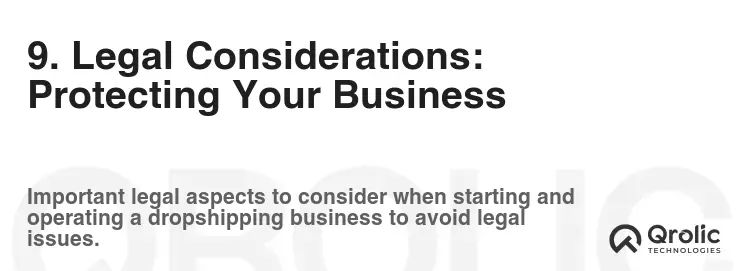
It’s crucial to understand and comply with all relevant legal requirements to protect your business.
Key Legal Considerations:
- Business Structure: Choose the appropriate business structure (e.g., sole proprietorship, LLC, corporation).
- Business Licenses and Permits: Obtain any necessary business licenses and permits.
- Privacy Policy: Create a privacy policy that complies with data privacy laws.
- Terms and Conditions: Develop clear terms and conditions that outline the rules and regulations of your website.
- Copyright and Trademark Law: Respect copyright and trademark law when using images, logos, and other content.
- Sales Tax: Understand your sales tax obligations.
- Consumer Protection Laws: Comply with consumer protection laws.
Disclaimer: This information is for general guidance only and does not constitute legal advice. Consult with a legal professional to ensure you are complying with all applicable laws and regulations.
10. Scaling Your Dropshipping Business: Growth Strategies

Once you have a solid foundation, you can start focusing on scaling your business.
Strategies for Scaling Your Dropshipping Business:
- Expand Your Product Line: Offer a wider range of products to attract more customers.
- Target New Markets: Expand into new geographic markets.
- Optimize Your Marketing Campaigns: Refine your marketing campaigns to improve ROI.
- Improve Customer Service: Provide even better customer service to increase customer loyalty.
- Automate Tasks: Automate repetitive tasks to free up your time.
- Hire Employees or Contractors: Delegate tasks to employees or contractors.
- Invest in Technology: Invest in technology to improve efficiency and productivity.
- Negotiate Better Deals with Suppliers: Negotiate better pricing and shipping terms with your suppliers.
- Branding: Invest in building a strong brand to differentiate yourself from the competition.
- Email Marketing Automation: Segment your email list to better target your products and offers to your customers.
11. Qrolic Technologies: Your Partner in E-Commerce Design and Development

Looking for expert assistance in designing and developing your dropshipping website? Qrolic Technologies (https://qrolic.com/) offers comprehensive e-commerce solutions tailored to your specific needs. With a focus on user-centric design, cutting-edge technology, and results-driven strategies, Qrolic Technologies can help you create a visually stunning, highly functional, and conversion-optimized dropshipping website.
Why Choose Qrolic Technologies?
- Experienced E-Commerce Developers: A team of skilled developers with expertise in various e-commerce platforms.
- Custom Design Solutions: Unique and engaging designs that reflect your brand identity.
- SEO Optimization: Built-in SEO features to ensure your website ranks well in search engines.
- Mobile-Responsive Design: Ensuring your website looks great on all devices.
- Ongoing Support and Maintenance: Reliable support to keep your website running smoothly.
- Dropshipping Expertise: Deep understanding of dropshipping requirements and best practices.
Services Offered:
- E-Commerce Website Design and Development: Creating custom dropshipping websites from scratch.
- Theme Customization: Customizing existing themes to meet your specific needs.
- App Integration: Integrating essential dropshipping apps and tools.
- SEO Optimization: Improving your website’s search engine rankings.
- Website Maintenance and Support: Providing ongoing support and maintenance services.
Contact Qrolic Technologies today to discuss your dropshipping website needs and take your online business to the next level.
Conclusion: Your Journey to E-Commerce Success Starts Now
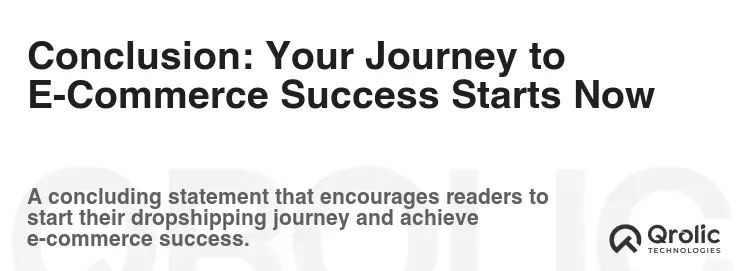
Creating a successful dropshipping website requires careful planning, execution, and continuous optimization. By following the steps outlined in this comprehensive guide, you’ll be well-equipped to build a thriving online business, achieve financial freedom, and live life on your own terms. Remember to choose your niche wisely, select the right e-commerce platform, design a captivating website, find reliable suppliers, market your business effectively, and prioritize exceptional customer service. Embrace the challenges, learn from your mistakes, and never stop innovating. Your dropshipping journey starts now!







